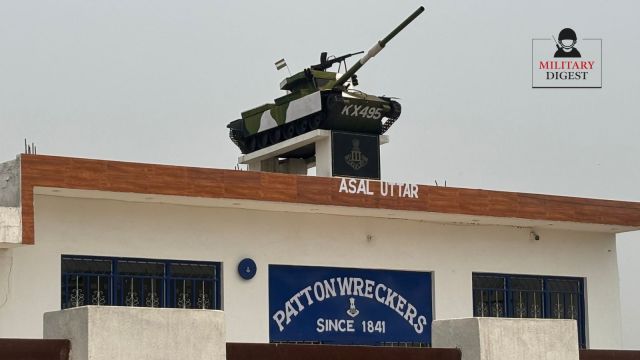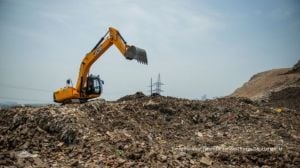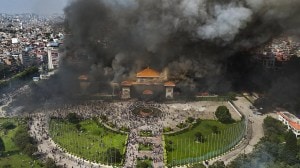Military Digest | From despair to victory: How Pakistani tanks were given crushing defeat in Asal Uttar
It was in this last battle on September 10 that Company Quarter Master Havildar Abdul Hamid of 4 Grenadiers won the Param Vir Chakra and the Commander Artillery of Pakistan Army’s armoured division, Brig AR Shammi was killed while the GOC of Pakistan armoured division had a narrow escape.
 Memorial of 3 Cavalry Regiment at Asal Uttar. (Express photo by Man Aman Singh Chhina)
Memorial of 3 Cavalry Regiment at Asal Uttar. (Express photo by Man Aman Singh Chhina)
The nondescript village of Aasal Utaad in Tarn Taran district of Punjab is today known for the tank battle which was fought in its vicinity between September 8 and 10 in 1965, and which gave it the name by which it is now famous — Battle of Asal Uttar.
The name Aasal Utaad originated from ‘Aasal’, the name of the village near Kasur, now in Pakistan, from where some Jat Sikh families migrated to the new location in Patti tehsil and established another village by the same name some 400 years ago. Utaad in Punjabi means ‘upper’. Since this new village was established on the upper bank of
Satluj, it came to be known as Aasal Utaad.
In terms of the battle fought here between Indian and Pakistani tanks 60 years ago, the name has got corrupted to Asal Uttar which means ‘real reply’. It is an apt name for the battle which broke the back of Pakistan’s armoured assault on Indian soil and their ambitions to capture the bridge over Beas River and then have an unchecked drive onwards to Jalandhar, Ambala and eventually New Delhi.
The backdrop of the battle
On September 7, the mood in HQs 11 Corps was sombre. The Indian battalions in forward locations in Khemkaram sector had fallen back in face of Pakistani tank attacks and the Corps Commander, Lt Gen JS Dhillon was furious. He had visited HQs 4 Mountain Division, which was deployed in the area around Khemkaran, and had been put off by what he saw and learnt.
He wrote a detailed letter to the Western Army Commander Lt Gen Harbaksh Singh, painting a despondent picture. As per the details made public by Lt Gen Harbaksh Singh in his book, ‘War Despatches: Indo-Pak Conflict 1965’, Lt Gen JS Dhillon said six infantry battalions had been reduced to half their numbers due to mass desertions.
The Corps Commander highlighted desertions in 13 Dogra, 9 Jammu and Kashmir Rifles (JAKRIF), 18 RAJRIF and 7 Grenadiers. He mentioned that only 4 Grenadiers and 1/9 Gorkha Rifles were intact and that apart from these two battalions, the other four should be disbanded and the 4 Mountain Division be replaced by another devision.
The Army Commander thought the Corps Commanders recommendations were “drastic” and decided to visit the Division himself. He found the situation serious but did not feel that any severe measures were required and found that the General Officer Commanding (GOC) of the division was self-confident. As subsequent events proved, 4 Mountain Division proved itself to be equal to the task given to it and halted the Pakistani advance by giving them a crushing defeat at Asal Uttar.
Battle of Asal Uttar
The Pakistani operational plans envisaged them to be in Harike by the afternoon of September 8 and capture the bridge over Beas river by next evening. Lt Gen Harbaksh Singh states that the Pakistani plan was to exploit the lay of the land and use the direction of canals, drains and nallahs for their advance.
On October 8, the Pakistani tank regiments made a series of attacks on Indian positions with two squadrons of Chafee tanks and one squadron of Patton tanks. These enemy attacks were repulsed by Indian tanks of 9 Horse (Deccan Horse) and the Pakistanis withdrew with 14 tanks damaged or destroyed.
On the same day another tank attack was mounted by Pakistan Army along with motorised Infantry. They succeeded in over running some positions of 1/9 Gorkha Rifles but were beaten back by Indian tanks deployed around Bhikhiwind and troops of 4 Grenadiers. The Pakistani motorised infantry battalion disintegrated due to large-scale desertions as the Pakistani soldiers literally ran back.
Induction of 2 (Independent) Armoured Brigade
Analysing that a major Pakistani armoured attack was imminent, the GOC 11 Corps placed 2 (Independent) Armoured Brigade under 4 Mountain Division and the brigade took up its new positions near Asal Uttar, Chima, Dibbipura, Valtoha and War Nala. The Indian tank regiments deployed were Deccan Horse, 3 Cavalry and 8 Cavalry.
On October 9, the Pakistanis again made an attack and this time their tanks got bogged down in the sugarcane fields which had been flooded due to a breach in the nala and were destroyed by Indian tanks. The Pak infantry was routed by troops of 18 RAJRIF.
The main Pakistani attack took place on September 10 comprising two tank regiments, one motorised infantry battalion and at least a squadron of Chafee tanks. Lying in wait for this attack were tanks of 3 Cavalry and 4”soldiers of 4 Grenadiers just outside Village Chima.
When this attack was foiled, the Pakistanis made their way to Mahmudpura-Dibbipura villages where again Indian tanks were shadowing them and lying in wait from three directions. The result is history and the Pak armoured division was routed turning Asal Uttar into a graveyard of Pakistani tanks.
It was in this last battle on September 10 that Company Quarter Master Havildar Abdul Hamid of 4 Grenadiers won the Param Vir Chakra and the Commander Artillery of Pakistan Army’s armoured division, Brig AR Shammi was killed while the GOC of Pakistan armoured division had a narrow escape.








